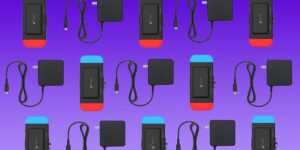When you buy through our links, Business Insider may earn an affiliate commission. Learn more
The best 85-inch TVs deliver a viewing experience that smaller displays simply can’t match. Though sets this big used to be few and far between, manufacturers now offer 85-inch versions of several of their most popular models, and though still expensive, they’ve come down a lot in price.
We’ve tested and researched the top options available to choose the best 85-inch TVs you can buy. The TCL QM8 offers the best balance between price and performance at this size thanks to its bright QLED panel and high-contrast Mini LED backlight. But if you want an 85-inch TV without breaking the bank, TCL’s cheaper Q6 QLED is a more budget-friendly alternative that’s often on sale for under $900.
We also have picks for OLED and 8K models at this size, so all home theater needs are accounted for.
Note: LCD-based TVs (LED, QLED) are often manufactured in an 85- or 86-inch screen size, but OLED displays are sold in a slightly smaller 83-inch size. For that reason, we’ve included an 83-inch OLED TV in this guide.
Our top picks for the best 85-inch TVs
Best overall: TCL QM8 4K QLED TV – See at Amazon
Best for home theaters: LG C3 4K OLED TV – See at Amazon
Best on a budget: TCL Q6 QLED 4K TV – See at Amazon
Best midrange QLED: Hisense U7K QLED 4K TV – See at Amazon
Best 8K display: Samsung QN900C QLED 8K TV – See at Amazon
Best overall
TCL 85-inch QM8 QLED 4K TV
This is the lowest price we’ve ever seen for the 85-inch size of TCL’s flagship 4K QLED TV. It competes with much pricier models and offers one of the brightest panels on the market, along with great contrast control. This model typically sells for an average street price of around $2,100, so this deal offers great savings.
When balancing price and image quality, TCL’s QM8 QLED is the best 85-inch TV you can buy. It’s incredibly bright while maintaining excellent contrast thanks to the precision of its Mini LED backlight with local dimming capabilities. And despite its extra-large size, it’s often on sale for under $2,000, which is fantastic for a display this big with this level of performance.
Though we recommend OLED models, like the Samsung S90C, as our top pick in many of our other best TV buying guides, OLEDs at this screen size jump up a lot in price and are missing some of the color and brightness perks that their smaller counterparts offer. We think an OLED will still deliver better overall image quality, but the QM8 QLED has a slight edge in value for most people, and it even has a few features OLEDs lack at this size.
The QM8’s color volume is especially impressive thanks to its quantum dot filter, which is something you won’t find on competing OLEDs over 77 inches. Quantum dots also help the TV achieve a peak brightness of around 2,000 nits, which is more than enough to enjoy the full benefits of most HDR content.
It has a leg up over cheaper QLED models thanks to the QM8’s high number of local dimming zones, which helps it achieve deep black levels without major halos around bright objects. However, contrast still can’t match the pixel precision of an OLED panel, so you might see the dimming zones at work during certain scenes when watching TV in a dark room.
When reviewing the QM8, we also noticed slight issues with shadow details getting lost in dimmer scenes, but this can be mitigated by adjusting some of the display’s settings. But the QM8’s biggest weakness is its viewing angles. Colors and contrast distort when you sit off to the side of the screen. If you want a similar 85-inch QLED TV with better off-axis viewing, we recommend Samsung’s more expensive QN90C. Otherwise, you’ll need to pay substantially more for an OLED like the LG C3.
With Google TV built-in, the QM8 offers a reliable interface and easy access to all of the best streaming services. The TV is also a great fit for gamers thanks to its fast panel with up to a 144Hz refresh rate when paired with a compatible PC. The TV’s build and design aren’t as premium as more expensive models, but the QM8’s strengths far outweigh its cons.
Read our TCL QM8 4K TV review.
Best for home theaters
LG 83-inch C3 OLED 4K TV
The 83-inch C3 offers all the image quality benefits that OLEDs are known for — including pixel-level contrast control, true black levels, and wide viewing angles — in an extra-large screen.
If you want an 83-inch TV that’s best suited for a dark home theater room, there’s no substitute for an OLED like the LG C3. It’s more than double the price of most QLED models in the 83-to-85-inch category (OLEDs are generally available as 83-inch models), but the LG C3 delivers an infinite contrast ratio with true black levels and wider viewing angles than any QLED.
Though not as bright as most of our other picks, the C3 can still produce a peak of about 800 nits, which is still fine for most rooms and enough to deliver good HDR highlight performance. Color volume isn’t as high as our top pick, the QM8, so bright colors won’t be quite as intense, but we think the C3’s superior pixel-level contrast control is a bigger advantage than any of the QM8’s strengths. In a dark home theater setting, the C3’s overall image quality simply outmatches any QLED we’ve tested, offering one of the best movie-watching experiences you can get from an 83-inch TV. However, the C3’s image quality isn’t as good as some OLED models you can get in smaller sizes.
The Sony A95L and Samsung S95C OLED TVs are brighter and more colorful than the C3, but they’re not sold in sizes above 77 inches. And though LG’s step-up G3 is available in this size, the 83-inch model is missing micro-lens array (MLA) technology. That feature is included in smaller sizes and enables the G3 to get much brighter than the C3. But without MLA, the performance difference between the 83-inch G3 and C3 is minimal and not worth the big price gap.
There’s also the Samsung S90C OLED to consider, but again, the 83-inch model is missing a key image quality feature that its smaller siblings include. In this case, its quantum dots, which normally give the S90C an edge in color and brightness over the C3. But without quantum dots, the 83-inch S90C and LG C3 are more evenly matched. And since the C3 supports Dolby Vision to provide a more refined HDR experience, we think it has a slight edge over the S90C at this size.
Best on a budget
TCL 85-inch Q6 QLED 4K TV
The Q6 is one of the most affordable QLED TV you can get in an 85-inch screen size. Thanks to its quantum dot panel, it delivers better color performance than cheaper sets this big.
The best 85-inch TVs don’t come cheap. Even basic models rarely dip below $800, and those sets make many performance sacrifices to get that cheap. However, there is one 85-inch TV that still manages to deliver solid image quality for a typical sale price of just under $900: the TCL Q6 QLED.
Other options that cost a bit less, like the Hisense A7 and the step-down TCL S4, use regular LED panels without quantum dots, which limits their color volume and brightness performance. But the Q6 offers a more vibrant and accurate HDR image while remaining competitively priced for its size.
That said, the Q6 still has drawbacks compared to pricier models. Viewing angles are narrow, so picture quality takes a big hit if you sit to the side of the screen. This is common for TVs in this class, so if viewing angles are a priority over color gamut, we recommend going with an alternative budget model like the 85-inch LG UQ75 instead. And like many TVs in this class, the Q6 is limited to a 60Hz screen rather than 120 or 144Hz, which makes it less suited for high-end 4K gaming.
Though brighter than cheaper 85-inch sets, the Q6 maxes out at around 500 nits, lower than the 600-nit range we typically recommend as a starting place for budget HDR TVs. It also lacks local dimming, so it can’t adjust brightness across different zones on the screen. This leads to elevated black levels compared to step-up models, like the TCL Q7 or Hisense U7K.
For most screen sizes, our go-to budget pick is the Hisense U6K which does have local dimming. But unfortunately, that model isn’t offered in sizes above 75 inches. As it stands, the Q6 is the most affordable 85-inch QLED TV you can buy, and compared to its direct competitors, it delivers great value for the money.
Best midrange QLED
Hisense 85-inch U7K QLED 4K TV
Hisense’s U7K is an excellent midrange 85-inch TV. It can’t get quite as bright as more expensive QLED models, but it still delivers great HDR performance and high refresh rate gaming support.
The Hisense U7K is a great TV for buyers who want something between our best overall and best budget picks. It can’t get as bright as pricier displays, but it’s one of the cheapest 85-inch TVs with local dimming.
Thanks to its Mini LED backlight, the U7K can use hundreds of dimming zones to brighten and darken specific segments of its screen. This leads to good black-level performance and contrast control for a TV of this type, so bright highlights can shine while dark elements of an image remain dim. Local dimming is missing from most cheaper 85-inch TVs, like the TCL Q6, so the U7K offers a sizable upgrade in overall image quality.
More expensive QLED models, like the TCL QM8, can still deliver higher contrast and get brighter, but the U7K is no slouch, with a peak of around 1,000 nits. And its quantum dot filter enables it to produce a wide range of colors. Unfortunately, like most QLED TVs, viewing angles are subpar, so sitting off-center will cause the display’s color and contrast to fade. The TV’s build also feels a bit cheap compared to models from brands like Samsung, LG, and Sony.
On the plus side, the U7K supports all of the latest gaming features on consoles like the PS5 and Xbox Series X, and it can support a high 144Hz refresh rate when paired with a PC. The display’s Google TV interface works well enough, but navigation isn’t as smooth as it is on some higher-end TVs.
Read our Hisense U7K 4K TV review.
Best 8K display
Samsung 85-inch QN900C QLED 8K TV
The benefits of 8K resolution are subtle, but the 85-inch QN900C is an impressive display with some of the best contrast and color performance we’ve seen on any QLED TV.
Though we still think most buyers are better off with a high-end 4K TV, 8K displays like the Samsung QN900C have their fans, especially at extra-large screen sizes. At 85 inches, an 8K TV will offer some benefits over 4K thanks to its higher pixel density, which means you can sit very close without seeing individual pixels like you would on a 4K set this large.
However, it’s important to remember that the perks of 8K remain subtle. There’s still no native 8K content to watch outside a few YouTube videos, and though the TV’s upscaling looks great, it’s not a big improvement over watching the same content on a 4K TV with similar capabilities.
But even ignoring its 8K resolution, the QN900C is just a stunning QLED TV through and through. Its Mini LED backlight is one of the best out there, and it gets about as close to OLED-level contrast as we’ve seen on a display like this. It also has an incredible peak brightness of about 2,300 nits, and it can sustain that brightness much better than an OLED.
This is one of the best Samsung TVs you can buy, but its impressive picture quality is more a result of its dimming performance and quantum dot colors rather than its actual pixel count. If you prioritize picture quality, we still think you’re better off with a 4K OLED like the LG C3, but if you’re set on buying an 8K display, the QN900C is easily one of the top 85-inch models to snag.
How we test 85-inch TVs
Steven Cohen/Insider
To choose the best 85-inch TVs, our team relied on a combination of hands-on testing and research informed by more than a decade of experience covering the home entertainment product market.
When we review TVs, we typically evaluate each model’s 65-inch option since that’s considered the industry’s flagship size. However, a model’s overall performance often remains comparable across sizes 55 inches and up. For example, an 83-inch LG C3 OLED and a 65-inch C3 OLED have the same specs. The only notable difference is the size of each panel.
However, there are instances when certain TV models have more dramatic differences across their screen sizes. For instance, the Samsung S90C uses quantum dots on its 55-, 65-, and 77-inch models but does not use quantum dots on its 83-inch model. This means that the 83-inch model can’t match the color performance of its smaller counterparts. We take all of these differences into account when recommending TVs and detail these instances when they pop up.
To evaluate displays, we look at key picture quality elements like color performance, clarity/sharpness, contrast control, HDR brightness, refresh rate, smart TV interface speed, off-angle viewing, and overall value. We use an X-Rite iDisplay Plus colorimeter and test patterns on the Spears & Munsil UHD HDR Benchmark 4K Blu-ray disc to check the brightness and other objective image attributes.
We also rely on various movies and TV shows to look at real-world performance. We’ve selected specific scenes to compare performance across TVs with black levels, shadow detail, HDR capabilities, and upscaling in mind. Sources include 4K, 1080p, and standard definition (SD) material from Blu-rays, streaming services, and cable TV.
85-inch TV FAQs
Steven Cohen/Business Insider
Is 85 inches a good TV size?
The best 85-inch TVs can provide a level of immersion that smaller displays can’t achieve, and they’re especially good for larger rooms since you can sit farther away and still get a cinematic experience. Though there are fewer 85-inch models to choose from compared to smaller screen sizes, several of our picks for the best 4K TVs are sold in 83 to 85-inch versions.
However, many rooms simply can’t accommodate a TV this big, and 85-inch sets are typically pricey. If you need a smaller display, check out our guides to the best 75-inch TVs, best 65-inch TVs, and best 55-inch TVs to see our top recommendations.
How much should you spend on an 85-inch TV?
Generally, you should expect to pay at least $900 to snag one of the best 85-inch TVs, though high-end models cost $5,000 or more.
We’ve seen entry-level 85-inch LED TVs on sale for as low as $750, but budget QLED models typically start at around $1,000, and midrange options with local dimming and higher brightness capabilities sell for around $1,500 to $1,800. High-end 85-inch QLED 4K TVs with the best performance usually cost around $2,000 to $3,000, and 8K models can be between $5,000 and $7,000.
If you want one of the best OLED TVs in this size, you can find 83-inch options starting at around $3,500, while high-end 4K OLEDs this big can cost as much as $6,500.
Is 4K resolution enough for an 85-inch TV?
In general, 4K resolution is plenty to deliver a sharp and detailed image on an 85-inch TV. That said, the higher pixel density of an 8K display can present some improvements in picture clarity if you sit very close to your TV.
On an 85-inch set, improvements in pixel smoothness should start to become most visible if you sit less than five feet from your display. However, for most people, this subtle benefit is not worth the extra money that an 8K TV costs.




